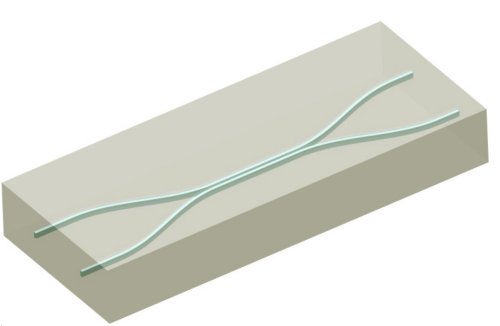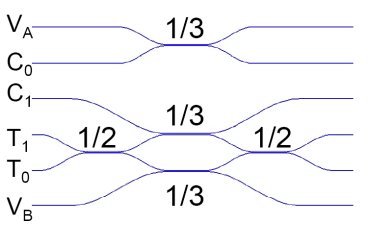
Researchers in the UK have taken a small but important step towards the creation of practical quantum computers by creating the first logic gates on a silicon chip that can process individual photons. The chip, which measures several millimetres across, reproduces an earlier version of the gate that occupied several square metres of space on an optical bench.
Individual photons of light show great promise as quantum bits of information (qubits) in a quantum computer because they can travel great distances through optical fibres or even air without losing their quantum nature. One reason for this is that individual photons of light do not normally interact with each other. However, this makes it hard to create devices for processing quantum information such as logic gates, which rely on the interaction of two or more photons.
Target and control
In 2003 Jeremy O’Brien at the University of Bristol and colleagues in Australia built the first controlled NOT (CNOT) quantum logic gate for single photons. A CNOT gate has two inputs – “target” and “control” – and is considered a fundamental building block of any quantum computer. If no photon enters the control input, which corresponds to a “0”, then the logical state of the target (“0” if no photon enters or a “1” if a photon enters) remains unchanged. However, if the control is set to 1 (i.e. a photon enters) the state of the target is flipped from 1 to 0 and vice versa.
However, O’Brien’s first gate was made using conventional optical components such as mirrors and beam splitters and was spread out over a laboratory bench – not very practical for making a quantum computer, which would require thousands of such gates.
Silica waveguides
Now, O’Brien along with Alberto Politi, and colleagues at the University of Bristol have built hundreds of versions of the same gate in a millimetre-sized piece of silicon (Sciencexpress). Instead of mirrors and beam splitters, they used coupled waveguides – micrometre-wide channels of transparent silica that can be created in silicon using a well-established industrial process.
Each gate contains six parallel waveguides that are normally separated by tens of micrometres of silicon so that the photons do not interact. However, at certain points along the device, pairs of waveguides are brought very close together so they are separated by a distance on a par with the wavelength of the photons (about 800 nm).
At these points, some of the light can leak from one waveguide to the other in a process called evanescence. This effect is widely used in commercial optical communications devices that split a beam of light into two beams.
However, if two photons travelling in separate waveguides come close together at the same time they experience quantum interference. At this point the two photons become entangled — a feature of quantum mechanics that allows particles to share a much closer relationship than classical physics allows. The CNOT gate works by performing a series of three such entangling processes on the target and control photons as they move through the chip.
Although the devices were shown to be very good at entangling photons, O’Brien told physicsworld.com that they have an inherent success rate of 1/9, which means that nearly 90% of the input photons are not processed correctly. In principle, these incorrect results could be rejected by using verification qubits – other photons that interact with the target and control qubits via additional coupled waveguides — and determine whether the CNOT process was successful.
Verification schemes
The Bristol team are currently working on implementing verification schemes and also exploring how photon sources and detectors – which are currently off-chip – could be integrated within the chip.
O’Brien described the gates as “a very important step [towards practical quantum computers], but a very small step”.




